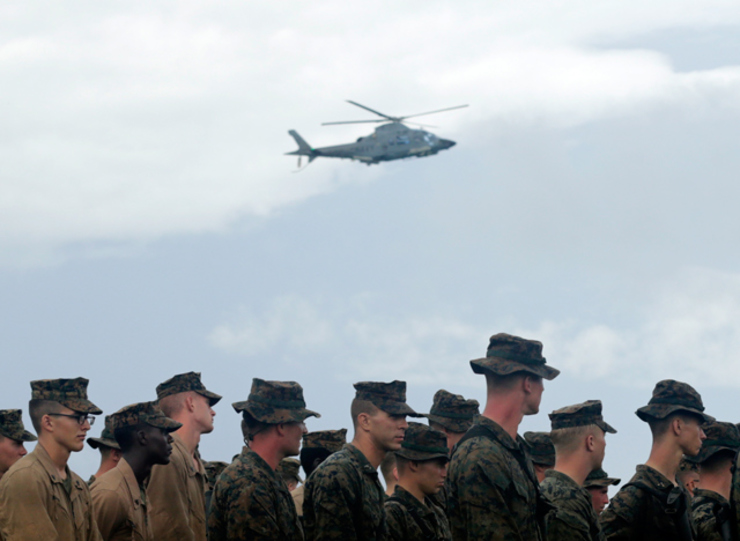From Rappler (Jul 5):
CARAT PH: 20 years of enhanced PH-US maritime cooperation (by Agatha Alexis Bermachea)
What exercises such as CARAT make clear is that there is real continuity between operations and training in the region
 MARITIME
COOPERATION. CARAT Philippines
is a bilateral exercise series between the Philippines'
Navy and the U.S.
Navy to strengthen maritime partnership, amid increasing regional tensions over
territorial disputes in the South
China Sea. File photo by Francis R.
Malasig/EPA
MARITIME
COOPERATION. CARAT Philippines
is a bilateral exercise series between the Philippines'
Navy and the U.S.
Navy to strengthen maritime partnership, amid increasing regional tensions over
territorial disputes in the South
China Sea. File photo by Francis R.
Malasig/EPA
In a matter of days, naval forces from the Philippines and the United States carried out training that ran the gamut of maritime operations taking place in dispersed locations across the Philippine archipelago.
Cooperation Afloat Readiness and Training (CARAT) marks its 20th year with the Philippines, one of the original partner countries when the US Navy began the exercise in 1995. US Navy Lieutenant Commander Clay Doss from the staff of Commander Task Force 73 described CARAT as their premier navy-to-navy engagement, with the 2014 iteration including 9 partner countries in South and Southeast Asia whom they engage on a bilateral basis.
The training promotes regional maritime cooperation that contributes to the shared objectives of stability and prosperity. Each engagement is tailored to the security challenges and current dynamics of each partner country.
According to US Navy Commander Chris Van Avery of the Joint US Military Assistance Group based in Manila, the skills practiced during CARAT help both the US and the Philippines better understand each other, as well as their capabilities and limitations in disaster response.
While the Enhanced Defense Cooperation Agreement was signed in April 2014 and CARAT Philippines began in 1995, there are aspects which are clearly complimentary as seen in the Agreement.
The guidance of Article 1 covers the “shared goal of improving interoperability of the Parties’ forces, and for the Armed Forces of the Philippines, addressing short-term capabilities gaps, promoting long-term modernization, and helping maintain and develop additional maritime security, maritime domain awareness, and humanitarian assistance and disaster relief capabilities” which is common. CARAT 2014 certainly addresses core areas from Article 1. (READ:
PH, US warships to hold drills near disputed sea)
Operating together underway
The Guided-missile destroyer USS John S. McCain (DDG 56) and the dock landing ship USS Ashland (LSD 48) set sail with Philippine Navy frigates BRP Gregorio Del Pilar (PF 15) and BRP Ramon Alcaraz (PF 16) for the at-sea phase in waters to the west of Subic Bay. The 4 vessels sailed in formation conducting maneuvers and refining their shipboard communication procedures. They carried out an exercise where two ships would form a surface action group, with the two groups of vessels facing off to conduct mock engagements in the open ocean environment. Training proceeded to gunnery drills with ships engaging towed targets with surface fires, including the Del Pilar-class frigates utilizing their 76mm Oto Melara automatic cannons.
The at-sea portion also incorporated aviation assets from both navies, increasing the complexity and necessary coordination. The John S. McCain embarked a group of 9 Filipino shipmates led by Philippine Navy Captain Karl Decapia who joined with US Navy Captain Paul Schlise, Commodore of Destroyer Squadron 7, to lead the combined afloat staff.
They conducted a “detect to engage” sequence while operating in formation; in this case the potential threat that was being tracked in the skies was a US Navy P-3C Orion Maritime Patrol Aircraft acting as an aggressor above their colleagues below on the surface.
The aviation contingent included two AgustaWestland AW-109 "Power" helicopters embarked onboard on the Del Pilar-class frigates, 3 of which were commissioned into the Philippine Navy in December 2013. These 3 will be followed by two additional AW-109 helicopters expected to be delivered in the second half of 2014. The helicopters conducted a series of air operations where they would land, recover, and re-launch to simulate a real-world operational tempo.
One of the most important outcomes of this training was that these Philippine Navy helicopters achieved their Deck Landing Qualification onboard the John S. McCain.
In a combined response to a scenario such as a disaster relief mission, just like in the aftermath of Typhoon Yolanda where Ashland took part in Operation Damayan off the coast of the Visayas, this increased interoperability will provide commanders greater flexibility to respond while facing a rapidly evolving operational environment. A Philippine Navy helicopter could deliver essential supplies to victims in duress, land onboard a U.S. Navy vessel such as John S. McCain offshore to re-fuel and take on additional supplies, then re-launch to distribute the additional emergency aid to those in need.
Specialized skill training
While maneuvers at sea and key platforms from both navies constitute a major component of the exercise, the opportunity for subject matter experts to share knowledge with their alliance counterparts is an equally useful training opportunity.
The Military Operations and Law symposium was conducted ashore at Bonifacio Naval Station. This involved Philippine and US officers, including the Staff Judge Advocate General of the Philippine Navy, conducting a wide-ranging dialogue on legal issues that directly impacts how both navies operate at sea. Having a clear understanding of how an alliance partner sees key legal aspects allows for clear expectations with respect to their response to a range of scenarios.
The vital task of countering Improvised Explosive Devices (IEDs) remains a challenge for Filipino and US forces. The US Navy’s Explosive Ordnance Disposal Mobile Unit (EODMU) 5 deploys around the Western Pacific and areas beyond to support joint forces in countering threats including IEDs with personnel who have dealt with this threat on operations including in Afghanistan.
Their Philippine counterparts have also faced this hazard, such as during Operation Darkhorse in January when they raided a location in Barangay Ganta in Maguindanao where IEDs used in bombings in Central Mindanao were produced and in neighboring Shariff Aguak as a May response successfully diffused an IED that was to be detonated in front of the Municipal Hall.
CARAT 2014 included a subject matter exchange where the session covered hook and line techniques, robot operations, and breaching charges as methods to deal with this threat. Philippine and US EOD technicians trained on Caballo Island and conducted range clearance operations on live ordnance in an effort to demonstrate explosive opening techniques, remote movement techniques, and explosive tool utilization critical to real world operations.
Another skill set practiced was combat life-saving known as tactical combat casualty care. These medical procedures, for which Marines and Navy Corpsman train to conduct in a high-intensity combat environment, can literally save lives. This training included combat casualty assessment where those first responding to an injured colleague focus on rapidly diagnosing the medical concerns and taking steps to deal with those that are most life-threatening.
While these skills are developed to respond effectively to a fellow Marine who might suffer a potentially lethal injury in combat, they are also critical to disaster relief operations.
With the severe effects of winds seen during Typhoons Pablo and Yolanda, victims of the natural disaster can suffer traumatic injuries and the military is often the entity with the right capability to reach those in far-flung areas that are often cutoff by a severe storm. Accurately assessing the medical needs of these victims and providing time-sensitive care is an important capability Filipino and US forces contribute to relief operations.
What exercises such as CARAT make clear is that there is real continuity between operations and training in the region. It is patterns of cooperation that sustain key relationships between militaries that can be leveraged when called upon in response to a crisis.
Those forward-deployed US 7th Fleet vessels such as Ashland not only conduct exercises including CARAT with their counterparts from the Philippines, they also answer the call during crises as they did in rapidly responding to Typhoon Yolanda. The ability to work together effectively in a crisis reflects how this and other exercises have strengthened cooperation these past two decades. According to Captain Schlise, "CARAT Philippines 2014 has been the most complex CARAT ever undertaken between our two navies."
[Agatha Alexis Bermachea is a senior majoring in Asian Studies at the University of Santo Tomas who recently completed an internship at the Philippines Department of Foreign Affairs. Justin Goldman is an Associate Research Fellow at the S. Rajaratnam School of International Studies (RSIS), Nanyang Technological University.]
http://www.rappler.com/nation/62449-carat-philippines-20-years-enhancing-maritime-cooperation










